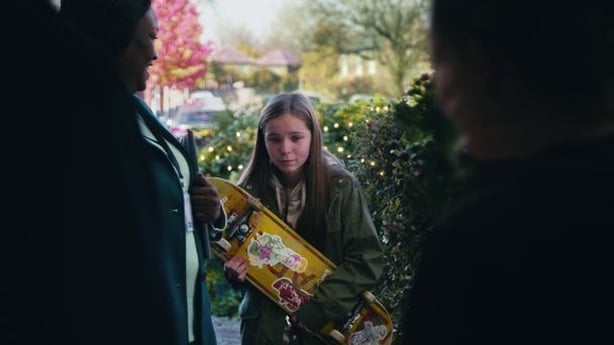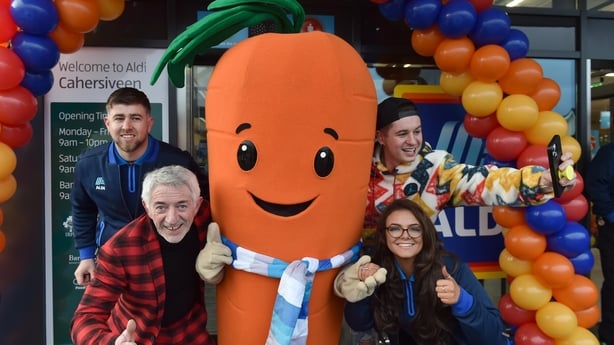A church bell chimes to herald midnight and – as the snow begins to fall – we see near-empty streets, towns and woods around the country, all against a backdrop of soaring choral music.
This is, ultimately, an attempt by a large multinational to get people to spend more money on their mass-market beer. Or, at the very least, to have their brand piggy-back on the positive feelings people have at this time of year.
Despite that, few would argue that Guinness' ad is now a core part of an Irish Christmas.
For some, its airing it marks the official start of the festive season.
"There is an ad that is very much timeless," says Deirdre Waldron, CEO of ad agency TBWA Dublin.
TBWA has been responsible for a range of Christmas ads including Supervalu’s 'Share the Magic’ campaign. But it can also trace its roots back to Irish International, the agency that created the classic Guinness ad.
"Certainly from an agency legacy perspective it’s something that everybody would be very proud of," says Deirdre. "One of the meeting rooms here is called ‘who’s going to turn the lights out?’, after that ad."
Guinness’ Christmas ad is 20 years old this year but it is clearly still held in high esteem – even outside of the confines of TBWA’s offices.
Last year it topped Red C’s ‘Who Won Christmas Ad Test’ - which looks at how an ad performs across a range of measures; including creativity, distinctiveness and emotional response.
And its continued appeal is in spite of the fact that it’s now airing in a much different Christmas ad market than the one that existed in 2004.
Of course brands and businesses have been making Christmas ads since the early days of broadcast. Even ones like Guinness’ - that go beyond simply telling you what products are available for sale – have existed for many decades.

Budweiser’s sleighbell-sporting clydesdales were trotting through the snow as far back as 1987. Kids have been leaving Santy Corn Flakes since 1991. Coca Cola’s light-laden lorries have been passing through snowy villages since 1995.
Another Irish Christmas classic – albeit for radio – also marks a big anniversary this year, as the Barry’s Tea ‘Train Set’ ad turns 30.
But while these kinds of ads have traditionally been a bit of a novelty, they now seem to be obligatory. And many believe there is one company that’s largely responsible for that shift.
"John Lewis is a really interesting example – for years they’ve been the standard-bearer for Christmas ads," said Rory Hamilton, chief creative officer with ad agency Boys and Girls, which has worked on numerous Christmas campaigns through the years, including Three Ireland’s ‘The Girl and the Cloud’.
"In loads of ways [John Lewis] got further and further away from what regular ads did – they became about the concept of friendship or joy."
Over the course of the past 18 years, John Lewis has developed a tried-and-tested formula for a winning Christmas ad. Generally, it consists of a beautifully-shot (sometimes surreal) mini-story with a heart-warming twist, all set to an acoustic cover of a classic song.
As it’s different every year, there is significant anticipation around the arrival of each year’s John Lewis ad. Rather than wait to catch it on TV, consumers seek it out on YouTube and social media, while countless news sites publish stories to mark its arrival.
All of which represents tonnes of free ad space for the company.

The ads work so well that many of them would be well known to Irish consumers - despite the fact that John Lewis doesn’t advertise here. And it’s prompted countless other brands to pile into the Christmas ad market in an attempt to replicate John Lewis’ success.
"Whether you like any individual chapter of that story – the fact that it’s anticipated tells you a lot," says Shane Doyle, group strategy director at marketing communications company Core.
"So a lot of brands will try to aim for that, but it’s notoriously difficult to achieve because it’s very hard to make a new ad that’s nostalgic."
Of course any company would love to be able to generate the buzz that John Lewis’ Christmas ads now almost guarantee. However with so many now trying to follow its playbook, it’s hard to stand out from the crowd.
Deirdre Waldron says for a Christmas ad to work it’s vital to find a reason for it to exist – rather than having a company make one just for the sake of it.
"We definitely interrogate that to say ‘is there a place for me at Christmas… is there a story I can tell that’s of interest?’," she says. "Because if it’s not of interest or not relatable, or of the zeitgeist… what’s the point really?
"We’ll look at it objectively and say ‘yeah, there is a role for you here’ or ‘no, there’s no role for you there’."
The value of an ad can depend not only on the brand itself, but the context it’s operating in too. The pandemic, for example, saw a number of companies create ads with themes around connectivity, distance and recovery, for example.
Deirdre says the discussions aimed at finding the right approach take place long before Christmas – with the planning for a festive campaign likely kicking off in March. (Work on Guinness’ classic ad began in August 2003 – more than 15 months before it would first air).
Key to a campaign’s success is also a need to intertwine it with what will be happening with the brand in the real-world come Christmas. For a retailer, for example, that would mean tying any advertising campaign in with their in-store merchandising and festive product range.

Campaigns nowadays are also about more than a 30 second TV spot – they need to have different approaches for different social media platforms, as well as other ways to ‘activate’ the message beyond the goggle-box.
"Media slide into one another – you look at the likes of second screening for example," says Shane. "And different cohorts consume different media in different proportions – you can’t just bank everything on one format; a big poster, or a big TV ad."
Retailer will also often run two, simultaneous ad campaigns – one that tries to tap into the festive mood, and the other that simply shows off the products they have in store.
"There’s the tactical ad, which is the selling turkeys or mobile phones or whatever else it is," said Rory. "And then there’s the brand level which is just trying to infuse some deeper meaning, which can last longer with people."
Generally-speaking, the latter is an attempt to tug at the heart-strings, or elicit some kind of emotional response from the viewer. The central goal is to link the brand with the positive feeling people have around Christmas time.
But given how crowded that particular end of the market has become, some brands have tried over the years to take a different approach in an attempt to stand out.
That can include striking a humorous tone – poking fun at the stresses and frustrations of the festive season, or even parodying the tropes of Christmas ads themselves.
"The famous example was Harvey Nicks in the UK, and they had a famous campaign called ‘Sorry, I spent it on myself’," says Shane from Core. "They release of really, really bad presents for very little money – like sink plugs and paper clips – and the whole joke of it was that you said you’d spent money on yourself rather than on someone you loved.
"It was almost the direct opposite of Christmas."
Other ‘anti-Christmas’ ads of the past include Mulberry, which ran a campaign based around the idea of people trying to one-up each other in the gifts they bought.
Ryanair also ran a campaign targeted at people dreaming of escaping the madness of being back home at Christmas.
Though, these kinds of ads have become less common in recent years.
"The likes of Covid stopped that because Christmas became more important to people and not to be made fun of," Shane says.
Rory Hamilton also warns that there is a thin line brands must walk when poking fun at Christmas – as consumers will respond poorly to anything that dips towards the negative.
"It’s a time when you try to be too subversive, people tend to reject it as being cynical and not Christmassy," he says. "I think you need to be really careful with how much you go against the grain of a Christmas ad, because people want to see lovely family values expressed and joy at Christmas.
"People who are too cynical about Christmas, I think people are slightly suspicious of and tend to kind of reject."

Another approach some brands have taken is to make their ads more immersive in order to pull viewers in.
This year Amazon has gotten actor Adam Driver to give dramatic readings of some of the site’s real product reviews – including one for a relationship-saving banana slicer.
Waitrose, meanwhile, has developed a murder mystery-style campaign based around a missing Christmas dessert.
"You can provoke intrigue by having different messages in different areas – the one warning that you’d have for any brands doing that is ‘don’t make people work hard’," says Shane. "Consumers are extremely smart and we should never underestimate how smart they are.
"They also are, understandably and correctly, lazy when it comes to consuming advertising – because why wouldn’t they be? The ads tend to be not what they’re looking for – they’re looking for programming or content."
But whatever the approach, a modern Christmas ad requires a lot of time, a lot of planning and – usually – an above-average budget.
So it begs the question – do these ads actually work?
"A lot of the time when you’re trying to advertise, you’re trying to influence people’s behaviour – so you look for times of year when the odds are in your favour," says Shane. "There is a significant set of behaviours that change at Christmas time.
"First of all, we’re gifting. Second of all, we’re self-gifting. And third of all we tend to be trading up in terms of treat behaviour and hosting behaviours."
This is why retailers tend to put more focus on their premium product lines at this time of year, he says.
Christmas is also one of the increasingly rare points in time where families spend time watching linear TV together.
"It’s an opportunity for a brand to say something larger at a time when they know people will gravitate back towards more traditional media," says Rory. "People will gather around the television, people will watch things that are slightly longer-form, together, as a mass audience."
To that end the ads are, of course, an attempt to drum up sales in the here and now.
But they’re also about getting a foothold in the consumer’s habits for the months to come. And while companies will do market research to see how consumers responded to their campaigns, they may need to be patient to discover their real impact.

"If you look at ads that are good and have a real emotional connection, they’re effectiveness tends to grow year on year," says Rory. "If you do want to get that nostalgia then quite often the second, third, fourth and fifth years of your Christmas ad can be more effective than your first – because people remember it fondly.
"That’s how you would end up in the situation like Guinness are in, or Barry’s. People start to look forward to it and as soon as it comes on it becomes one of those things that means it’s finally Christmas."
It’s this valuable prize that perhaps explains brand’s willingness to spend big on their Christmas campaigns. They may cost more on a per-second basis, but the hope is that their impact will be far bigger – and they’ll potentially have a replay value for years to come.
Guinness spent around €750,000 on its Christmas ad – equivalent to more than €1m today – on the expectation that it would run for up to three years.
It’s fair to say that was money well spent.
But given the changing nature of media, and how crowded the Christmas ad market has become, will it ever be possible for a new ad to achieve this kind of legendary status again?
Deirdre Waldron is optimistic.
"The ambition has to be that that would be the case – but briefs don’t always start there," she says, suggesting that any attempt to sit down and specifically create a ‘classic’ ad is doomed to failure. "They’ll start somewhere specific and then go into a timeless place."
Rory Hamilton points to a number of modern Irish ads that have already shown they have lasting power.
That includes An Post’s ‘Send Love’ Tin Man ad (now in its third year), Vodafone’s ‘Christmas Swim’ effort (now five years old) and Woodies’ ‘Broken Gate’ ad (also in its fifth year).
Few would want to predict whether any of those will still be airing in 2040 – but Rory says it’s important that brands keep trying to reach that rarified air.
"There’s a danger, as with Christmas music, if you stop refilling the canon and you stop making new Christmas music, you end up stuck with Noddy Holder and Maria Carey for all time," he says.







